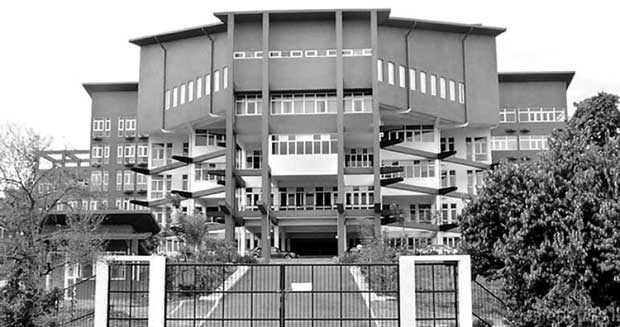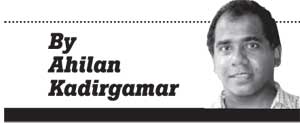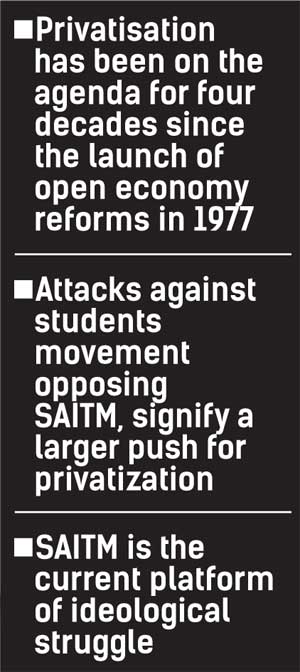A Brief Colonial History Of Ceylon(SriLanka)
Sri Lanka: One Island Two Nations
A Brief Colonial History Of Ceylon(SriLanka)
Sri Lanka: One Island Two Nations
(Full Story)
Search This Blog
Back to 500BC.
==========================
Thiranjala Weerasinghe sj.- One Island Two Nations
?????????????????????????????????????????????????Monday, July 3, 2017
SAITM and the Privatisation Push

 The
Govt in its policy statements and successive budgets has promoted
privatisation claiming it will bring private investment, increase
efficiency, better and expanded services, and relieve losses incurred by
SOEs. However, the urgency with which the Govt is seeking to promote
privatisation in recent months betrays a different set of reasons.
Central to the privatisation push of the current Govt is need for it to
sell state assets to pay back the large state debt accumulated over the
last decade. Having failed at prudent policies to manage such debt since
it came to power, its fall-back position is to sell state assets.
The
Govt in its policy statements and successive budgets has promoted
privatisation claiming it will bring private investment, increase
efficiency, better and expanded services, and relieve losses incurred by
SOEs. However, the urgency with which the Govt is seeking to promote
privatisation in recent months betrays a different set of reasons.
Central to the privatisation push of the current Govt is need for it to
sell state assets to pay back the large state debt accumulated over the
last decade. Having failed at prudent policies to manage such debt since
it came to power, its fall-back position is to sell state assets.
The mounting debt-driven crisis, the difficulties of attracting Foreign Direct Investment and the failure to increase state revenues through progressive taxes on the wealthier classes, have pushed the Govt into a corner. It is now seeking a one-time boost to state finances through privatisation.
Given public, and particularly trade union, resistance to such a fire sale of state assets, the Govt and certain allied classes forces are waging an ideological battle along the lines of efficiency and profits. These ideological moves are full of contradictions, including claims that cut throat profit seeking enterprises will provide better essential services to the public. Furthermore, the Govt disparages the state and its very institutions that it commands, instead of
strengthening them.
SAITM is the current platform of ideological struggle, and whether we like it or not, we are all participants in a debate on privatisation of higher education and healthcare. There are also the powerful financial interests, including the healthcare and insurance industries, waiting on the massive profits to be made. Meanwhile, preparations are underway for the large scale privatisation of state services in water, electricity and railways, to name a few. But that full assault of privatisation may only unfold after the economic crisis deepens.
During such a crisis, the Govt and its neo-liberal ideologues, the IMF and the World Bank, will seize the crisis as an opportunity and claim there is no option but to cut state services, sell state assets and pay back the debts to the foreign financiers. That was the message to the Greek people, as with many other countries around the world, with mounting economic crises. Such proponents of privatisation from the global financiers backed by international financial institutions to the local financial elite, are not concerned about efficiency or services, but about rent seeking. They are waiting to buy state assets for a song and make windfall profits.
Those who oppose SAITM, from the students to the GMOA,do it for different reasons. The current controversy over SAITM, addresses free education and health, as well as their regulation and private provision.The meaningful solution if we are to draw from our history would be expansion of free education and healthcare. The struggles and debates around SAITM have even larger stakes for our country and our people. We owe it to the students, for reminding us of the dangers facing our economic future, and the obligations of the state to its citizens.

The protests calling to close SAITM and their violent repression raise
several questions. Is the Government’s insistence on legitimising SAITM
merely a move about one private medical college? Is it the first move
towards increasing privatisation of education and healthcare? Or is it
about a larger agenda of privatising the many public services that the
state was historically responsible for?
Privatisation in its creeping form and in bursts and spurts has been on the agenda now for four decades since the launch of open economy reforms in 1977. On the other hand, resistance to such privatisation has been built on the postcolonial legacy of free education and health and other essential public services over the last six to seven decades.
The question is whether there is a shift in the push for privatisation at the current moment? If so, what is at stake and what are the consequences for the people?
Long-term agenda
Privatisation in its creeping form and in bursts and spurts has been on the agenda now for four decades since the launch of open economy reforms in 1977. On the other hand, resistance to such privatisation has been built on the postcolonial legacy of free education and health and other essential public services over the last six to seven decades.
The question is whether there is a shift in the push for privatisation at the current moment? If so, what is at stake and what are the consequences for the people?
Long-term agenda
"Two and a half years into the term of the Sirisena-Wickremesinghe Government, the increasing repression and brutal attacks against the student movement opposing SAITM, signify a larger push for privatisation including an ideological battle for the support of the public, which may decide the fate of state services and SOEs in the country."
The first wave of privatising State-Owned Enterprises (SOE) on a large
scale were initiated by the Premadasa Government starting in 1989 and
then again by the Kumaratunga Government starting in 1996. They focused
on select state sectors such as estates, telecommunications, and bus and
air transport. They brought financial proceeds to the governments and
capitalised the Colombo Stock Exchange,
which the financial classes were promoting. Furthermore, healthcare and
higher education have been privatised by stealth, with the emergence of
private clinics and hospitals and private higher educational
institutions established under the Board of Investments.
Exchange,
which the financial classes were promoting. Furthermore, healthcare and
higher education have been privatised by stealth, with the emergence of
private clinics and hospitals and private higher educational
institutions established under the Board of Investments.
Privatising SOEs, including through Public Private Partnerships (PPP), and commercialisation of health and education, were very much on the agenda of the Rajapaksa regime. Indeed, SAITM itself was initiated by the Rajapaksa Govt, even as it unveiled visions of medical and educational tourism.
While successive governments and powerful class interests mounted efforts to reshape the economy through privatisation for decades, I would argue that we are currently at the cusp of a possible shift that raises the stakes of the debate and struggles around privatisation. Two and a half years into the term of the Sirisena-Wickremesinghe regime, the increasing repression and brutal attacks against the student movement opposing SAITM, signify a larger push for privatisation including an ideological battle for the support of the public, which may decide the fate of state services and SOEs in the country.
 Exchange,
which the financial classes were promoting. Furthermore, healthcare and
higher education have been privatised by stealth, with the emergence of
private clinics and hospitals and private higher educational
institutions established under the Board of Investments.
Exchange,
which the financial classes were promoting. Furthermore, healthcare and
higher education have been privatised by stealth, with the emergence of
private clinics and hospitals and private higher educational
institutions established under the Board of Investments. Privatising SOEs, including through Public Private Partnerships (PPP), and commercialisation of health and education, were very much on the agenda of the Rajapaksa regime. Indeed, SAITM itself was initiated by the Rajapaksa Govt, even as it unveiled visions of medical and educational tourism.
While successive governments and powerful class interests mounted efforts to reshape the economy through privatisation for decades, I would argue that we are currently at the cusp of a possible shift that raises the stakes of the debate and struggles around privatisation. Two and a half years into the term of the Sirisena-Wickremesinghe regime, the increasing repression and brutal attacks against the student movement opposing SAITM, signify a larger push for privatisation including an ideological battle for the support of the public, which may decide the fate of state services and SOEs in the country.
Debt and ideological battle
 The
Govt in its policy statements and successive budgets has promoted
privatisation claiming it will bring private investment, increase
efficiency, better and expanded services, and relieve losses incurred by
SOEs. However, the urgency with which the Govt is seeking to promote
privatisation in recent months betrays a different set of reasons.
Central to the privatisation push of the current Govt is need for it to
sell state assets to pay back the large state debt accumulated over the
last decade. Having failed at prudent policies to manage such debt since
it came to power, its fall-back position is to sell state assets.
The
Govt in its policy statements and successive budgets has promoted
privatisation claiming it will bring private investment, increase
efficiency, better and expanded services, and relieve losses incurred by
SOEs. However, the urgency with which the Govt is seeking to promote
privatisation in recent months betrays a different set of reasons.
Central to the privatisation push of the current Govt is need for it to
sell state assets to pay back the large state debt accumulated over the
last decade. Having failed at prudent policies to manage such debt since
it came to power, its fall-back position is to sell state assets. The mounting debt-driven crisis, the difficulties of attracting Foreign Direct Investment and the failure to increase state revenues through progressive taxes on the wealthier classes, have pushed the Govt into a corner. It is now seeking a one-time boost to state finances through privatisation.
Given public, and particularly trade union, resistance to such a fire sale of state assets, the Govt and certain allied classes forces are waging an ideological battle along the lines of efficiency and profits. These ideological moves are full of contradictions, including claims that cut throat profit seeking enterprises will provide better essential services to the public. Furthermore, the Govt disparages the state and its very institutions that it commands, instead of
strengthening them.
SOE losses and PPPs
A central argument pushing for privatisation of SOEs are their losses.
However, there are varied reasons for such losses, including the
provision of free and affordable essential services to the public. Just
as education and health essential for a democratic and healthy society
should be free, the public should not be expected to deal with massive
market fluctuations in the prices of services such as water, electricity
and transport. And it is the role of the state to redistribute wealth
in the country towards social and economic stability and in the public
interest.
In reality, a regressive tax policy with extremely high indirect taxes; such as VAT and the increasing cuts to essential services, is further burdening the working people. Thus financing and strengthening SOEs through greater taxation of the wealthy is a much needed process of redistribution.
In reality, a regressive tax policy with extremely high indirect taxes; such as VAT and the increasing cuts to essential services, is further burdening the working people. Thus financing and strengthening SOEs through greater taxation of the wealthy is a much needed process of redistribution.
The Government’s push for privatisation is centred on PPPs, after all a partnership like friendship between
the public and private, is ideologically hard to oppose. In reality,
the history of PPPs around the world point to the private partner taking
the profits and the public left with the risk. With PPPs, governments
often build the infrastructure, while the private partner makes
strategic investments, but once the high profits are exacted and losses
emerge, the private partner exists, leaving the state to worry about the
essential services to its citizen. Alternatively, the PPP eventually
becomes completely private, and the public pay exorbitant prices for
essential services.
between
the public and private, is ideologically hard to oppose. In reality,
the history of PPPs around the world point to the private partner taking
the profits and the public left with the risk. With PPPs, governments
often build the infrastructure, while the private partner makes
strategic investments, but once the high profits are exacted and losses
emerge, the private partner exists, leaving the state to worry about the
essential services to its citizen. Alternatively, the PPP eventually
becomes completely private, and the public pay exorbitant prices for
essential services.
For the Govt, PPPs have become its route to offload state responsibilities. However, the history of many East Asian countries including Japan, reflect state direction and investment by development banks resulting in long-term sustained economic development and growth. Sri Lanka’s strategy of inviting speculative global finance, and firms run by short-term stock owner interests have only proven to destroy economies.
 between
the public and private, is ideologically hard to oppose. In reality,
the history of PPPs around the world point to the private partner taking
the profits and the public left with the risk. With PPPs, governments
often build the infrastructure, while the private partner makes
strategic investments, but once the high profits are exacted and losses
emerge, the private partner exists, leaving the state to worry about the
essential services to its citizen. Alternatively, the PPP eventually
becomes completely private, and the public pay exorbitant prices for
essential services.
between
the public and private, is ideologically hard to oppose. In reality,
the history of PPPs around the world point to the private partner taking
the profits and the public left with the risk. With PPPs, governments
often build the infrastructure, while the private partner makes
strategic investments, but once the high profits are exacted and losses
emerge, the private partner exists, leaving the state to worry about the
essential services to its citizen. Alternatively, the PPP eventually
becomes completely private, and the public pay exorbitant prices for
essential services.For the Govt, PPPs have become its route to offload state responsibilities. However, the history of many East Asian countries including Japan, reflect state direction and investment by development banks resulting in long-term sustained economic development and growth. Sri Lanka’s strategy of inviting speculative global finance, and firms run by short-term stock owner interests have only proven to destroy economies.
Crisis as opportunity
SAITM is the current platform of ideological struggle, and whether we like it or not, we are all participants in a debate on privatisation of higher education and healthcare. There are also the powerful financial interests, including the healthcare and insurance industries, waiting on the massive profits to be made. Meanwhile, preparations are underway for the large scale privatisation of state services in water, electricity and railways, to name a few. But that full assault of privatisation may only unfold after the economic crisis deepens.
During such a crisis, the Govt and its neo-liberal ideologues, the IMF and the World Bank, will seize the crisis as an opportunity and claim there is no option but to cut state services, sell state assets and pay back the debts to the foreign financiers. That was the message to the Greek people, as with many other countries around the world, with mounting economic crises. Such proponents of privatisation from the global financiers backed by international financial institutions to the local financial elite, are not concerned about efficiency or services, but about rent seeking. They are waiting to buy state assets for a song and make windfall profits.
Those who oppose SAITM, from the students to the GMOA,do it for different reasons. The current controversy over SAITM, addresses free education and health, as well as their regulation and private provision.The meaningful solution if we are to draw from our history would be expansion of free education and healthcare. The struggles and debates around SAITM have even larger stakes for our country and our people. We owe it to the students, for reminding us of the dangers facing our economic future, and the obligations of the state to its citizens.


